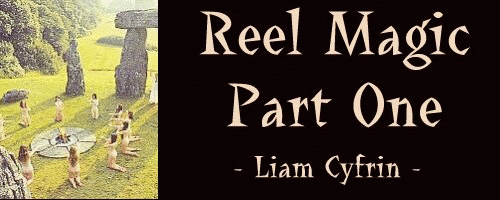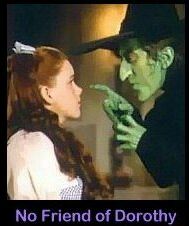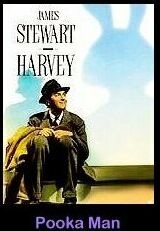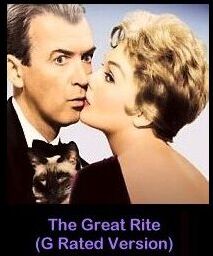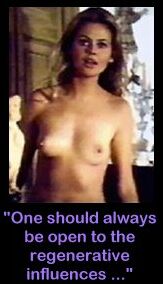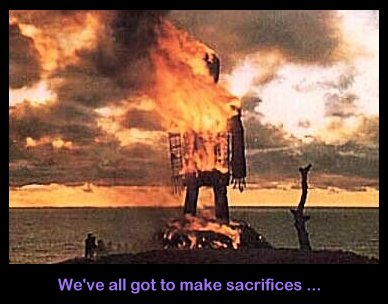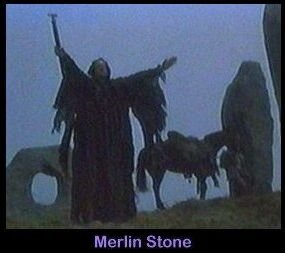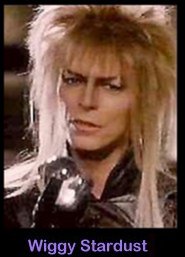 |
|||||||||||||
|
|
|||||||||||||
|
What we have for you here is a Witch’s dozen of the pick of the crop. Not all qualify as cinematic milestones but none are utter celluloid headstones either, and each is unconditionally guaranteed to contain a magical something that has contributed to the shaping of twenty-first century Witchcraft. Or at least the sort you get on the telly. Before you settle down with your popcorn and gallon cup of semi-glacial fizzy drink, I should point out that a list of thirteen purely Witchy films would have left us stranded deep in the heart of Turkeytown, staring glazedly at either too many fluffy, children’s films or too many schlocky horror shows with less esoteric wisdom to impart than a ride on a ghost train. For that reason, we’ve included a few supernaturally themed films without a Witch of any description in sight but with a whole lot more to teach about real magic than, say, Hocus Pocus. Or even Satan’s School for Girls. We’ve also weeded out films that represent the Craft as a sinister secret society out to getcha, so there’s no Rosemary’s Baby (1968) (a brilliantly nasty film that did the Craft absolutely no good at all by referring to the inner city demonologists as Witches), no The Witches (1990) (a dark gem of a children’s fantasy, based on Roald Dahl’s book, but one almost guaranteed to make anyone seeing it at an impressionable age Witchophobic for the rest of their lives), and definitely no The Blair Witch Project (1999) or its half-baked sequel (the only real influence on the Craft from this pair is that it’ll be years before skyclad rituals are no longer referred to as ‘bare Witch projects’). Unavoidably a few titles in the list below do incline just ever-so slightly to the paranoiac side of storytelling, but in each case other elements of the films made them shoo-ins for the top thirteen. A few classics of the silver screen bubbling just under the cauldron’s surface were: Witchcraft Through the Ages (1922) (an eccentric quasi-documentary SBS has been known to show now and then); Bedknobs and Broomsticks (1971) (the ‘Witch as supernatural Home Guard’ theme echoes elements of actual Wiccan history, the warning against questionable correspondence courses on Witchcraft remains timely, and the dead good scruffy little black cat makes Sabrina’s look like a complete pussy); Simon, King of the Witches (1971) (a quirky, rarely seen little number about a storm-drain dwelling magician, combining a swag of genuine magical theory and some very tasty satire); Roman Polanski’s Macbeth (1971) (featuring the most worrisome Coven ever to grace the screen - frankly, anyone gormless enough to address these ladies as ‘secret, black, and midnight hags’ deserves all he gets); and Four Rooms (1994) (one of the less inspired stories in which features Madonna as part of a more than usually ditsy Coven). But, with no further ado, the winners are:
Naturally, a highlight is the classic ‘good Witch/bad Witch’ routine by Billie Burke’s daft Glinda and Margaret Hamilton’s seriously scary Witch of the West, but look harder and you’ll find a whole flock of magical theories and teachings whizzing about like chickens in a twister.
He can’t, of course, but he does help them to discover that the powers they sought had been within them all the time, dormant until invoked by the dangers of the quest and their concern for each other. Very tidy and perfectly good magical theory. For attentive viewers, there’s plenty more surprises in the film’s imagery, few of which the book’s author or the screenwriters appear to have been consciously aware of. You can only suppose that the collective unconscious was working overtime to make this film happen. Though whether there’s any truth in the theory that the first half of the film synchronises perfectly with the old Pink Floyd Dark Side of the Moon album is a horse of a different colour!
Your classic story of Boy meets Giant Rabbit, Boy Loses Giant Rabbit, and so on and so forth. Not a Witch in sight in this beautiful little comedy but scratch the surface very slightly and you find the story of anyone who’s ever had a breathtakingly magical experience and is good-natured and naïve enough to believe they can safely share it with the rest of the world.
The message of this film for people in the Craft is to be cautious about sharing your own sense of the magical too freely, but not to give up on the practice altogether. Several people who initially think Elwood’s completely doolally eventually have their own vision of the prodigious bunny with life-changing results. Similarly, there’s always an outside chance that we can help open other people’s eyes to the magic around them if we care enough to make the effort. And as Elwood says, recalling his mother’s advice to him as a boy: ‘… in this life you must be oh so smart or oh so pleasant. For years I was smart. I recommend pleasant.’ Lovely film and still probably the very best on the subject of magic.
Kim Novak as our Crafty heroine sets new standards for the drop-dead (or, at least, drop-seriously-injured) gorgeous Witch in this one, though she wasn’t the first of glamour Witches to grace the screen. I’m not really sure who was but Veronica Lake in the equally fluffy comedy I Married a Witch looked distinctly stunning a good sixteen years earlier. We also meet our first vaguely counter-cultural Witch (well, ‘warlock’ in this film) in the heroine’s bongo-bashing beatnik brother, loopily played by Jack Lemmon, as well as our first investigative writer trying to get the low-down on the Witchy community. All in all, though Bell, Book and Candle is unrepentantly silly and a trifle old-fashioned now, you can’t help thinking the Charmed writers would be more than happy to update the plot if they thought no one would notice. Possibly they have and we didn’t.
In this sinister but very picturesque thriller, Edward Woodward (or Ed Woodwoodwoodwoodwood, as I tend to think of him) plays a police officer sent off to a Pagan community living on a Scottish island to investigate the disappearance of a young girl. Without giving the game away if you’ve not seen it, things do not go altogether well. In fact, the finale is, even by today’s standards, one of the most alarming things you’re likely to see on the screen.
The only catch is that the screenwriters, while scouring ‘The Golden Bough’ for folkloric details, happened upon the nastier aspects of the Pagan past as well as the brighter, and so the message of the film becomes: Pagan revivalism is dangerous because a percentage of the original rites got somewhat barbaric at times. This, of course, makes about as much sense as warning against stadium cricket or football matches on the basis that the original stadia were used for public executions and gladiatorial battles to the death. Still, structurally the film needs to end the way it does and, as long as it’s considered purely as fiction, it’s a fine, if ultimately gloomy, piece of work. Incidentally, most video versions are missing quite a slab of footage. Hopefully, a future DVD release will remedy that.
There are more Arthurian films than you could poke a broadsword at (and even more of the ropey ‘Sword and Sorcery’ epics that spawned Xena and chums), but when you’re talking magical theory, Excalibur is the one to go for.
When it first appeared, critics had a tendency to describe Excalibur as a Dark Ages version of Star Wars. Possibly maybe. In any case, not only is Williamson allowed infinitely more room to develop his role than Alec Guinness was in his equivalent part, but Merlin’s vision of the source of his power - the vast universal Dragon that flows through and gives form to all things - has it all over Lucas’s Force. While descriptions of the Force often make it sound about as mystical as plugging an electric toothbrush into a powerpoint, the Dragon is something alive and conscious, too huge to be comprehended but still able to be coaxed and swayed by the magician’s will. There’s no question of entirely mastering the Dragon. It is a wild, unpredictable creature likely to swallow you whole if treated with insufficient respect and intelligence. Which seems a pretty fair characterization of the more tempestuous reaches of magic. Naturally (or supernaturally), there are also lashings of magical swords, strange enchantments, Holy Grails, Knights Who Say ‘NI!’ (sorry, wrong film) and so on, but Williamson’s Merlin remains the show stopper. Admittedly, he has some spirited support from the likes of Gabriel Byrne, Helen Mirren, Patrick Stewart and, in his first film role, Liam Neeson who’d later go on acquire a light sabre of his very own.
Dismissed by some critics as ‘Ziggy Stardust meets the Muppets’, Labyrinth is an involving, if slightly rambling, look at how unmaking a spell is generally very much harder than getting the thing to work in the first place. Though no Teen Witch, Jennifer Connelly’s Sarah is the sort of teenage girl who’s reluctant to give up childhood dreams of magic (very sensible). Her problems stem from forgetting that, by choosing to live inside that magic, one winds up with all sorts of other dwellers of that realm as close neighbours. A misplaced and overheard wish forces her to go deeper into the labyrinthine dream world to find a way to undo the damage she’s carelessly caused, the small matter of having her baby brother kidnapped by goblins.
David Bowie doesn’t get to flex his dramatic muscles terribly much as the Goblin King but he manages to look natty in an outfit that very few mere humans could get away with, while banging out some neat boppy pop tunes and one immaculately sung, lovely slushy ballad. |
|||||||||||||
|
WebDesign: Rhea - Page last updated May 28, 2001 Copyright Shadowplay 2000, 2001. All Rights Reserved. |
|||||||||||||
